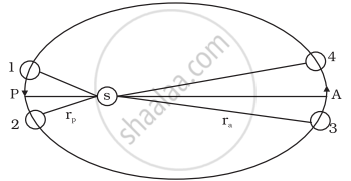Advertisements
Advertisements
प्रश्न
Earth’s orbit is an ellipse with eccentricity 0.0167. Thus, earth’s distance from the sun and speed as it moves around the sun varies from day to day. This means that the length of the solar day is not constant through the year. Assume that earth’s spin axis is normal to its orbital plane and find out the length of the shortest and the longest day. A day should be taken from noon to noon. Does this explain variation of length of the day during the year?
उत्तर
From the geometry of the ellipse of eccentricity e and semi-major axis a, the aphelion and perihelion distances are:
Angular momentum and areal velocity are constant as the earth orbits the sun
At perigee `r_p^2ω_p = r_a^2ω_a` at apogee.
If 'a' is the semi-major axis of earth's orbit, then `r_p = a(1 - e)` and `r_a = a(l + e)`
∴ `ω_p/ω_a = ((1 + e)/(1 - e))^2, e = 0.0167`
∴ `ω_p/ω_a = 1.0691`
Let ω be angular speed which is the geometric mean of ωp and ωa and corresponds to mean solar day,
∴ `(ω_p/ω) (ω/ω_a) = 1.0691`
∴ `ω_p/ω = ω/ω_a = 1.034`

If ω corresponds to 1° per day (mean angular speed), then w, = 1.034° per day and ωa = 0.967 per day. Since 361° = 14hrs: mean solar day, we get 361.034° which corresponds to 24 hrs 8.14" (8.1" longer) and 360.967° corresponds to 23 hrs 59 min 52" (7.9" smaller).
This does not explain the actual variation in the length of the day during the year.
APPEARS IN
संबंधित प्रश्न
Write the Kepler's laws.
State Kepler’s laws.
The mass and radius of earth is 'Me' and 'Re' respectively and that of moon is 'Mm' and 'Rm' respectively. The distance between the centre of the earth and that of moon is 'D'. The minimum speed required for a body (mass 'm') to project from a point midway between their centres to escape to infinity is ______.
The earth moves around the sun in an elliptical orbit as shown in the figure. The ratio, `"OA"/"OB"` = x. The ratio of the speed of the earth at Band at A is ______.

A planet revolves in an elliptical orbit around the sun. The semi-major and minor axes are a and b, then the time period is given by:
If the sun and the planets carried huge amounts of opposite charges ______.
- all three of Kepler’s laws would still be valid.
- only the third law will be valid.
- the second law will not change.
- the first law will still be valid.
If the sun and the planets carried huge amounts of opposite charges ______.
- all three of Kepler’s laws would still be valid.
- only the third law will be valid.
- the second law will not change.
- the first law will still be valid.
Supposing Newton’s law of gravitation for gravitation forces F1 and F2 between two masses m1 and m2 at positions r1 and r2 read F1 = – F2 = `- r_12/r_12^3 GM_0^2 ((m_1m_2)/M_0^2)^n` where M0 is a constant of dimension of mass r12 = r1 – r2 and n is a number. in such a case.
- the acceleration due to gravity on earth will be different for different objects.
- none of the three laws of Kepler will be valid.
- only the third law will become invalid.
- for n negative, an object lighter than water will sink in water.
Draw areal velocity versus time graph for mars.
Two planets A and B of equal mass are having their period of revolutions TA and TB such that TA = 2TB. These planets are revolving in the circular orbits of radii rA and rB respectively. Which out of the following would be the correct relationship of their orbits?
